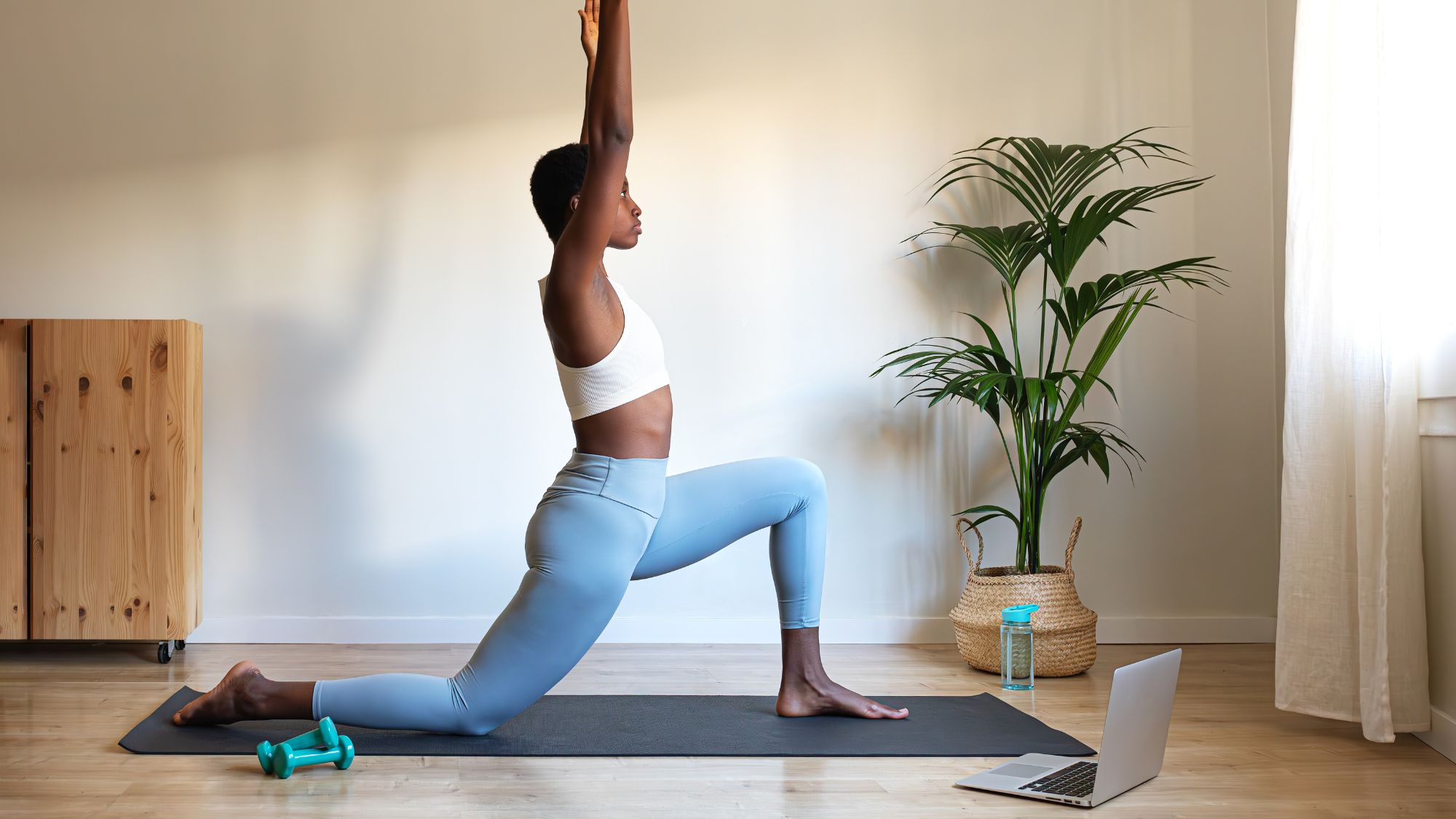Working Out Regularly But Still Not Seeing Results From Your Lunges? This Common Reason May Be Why
Runner's knee, be gone.


There’s no two ways about it - injuries suck. Whether you’re training for a specific event or working out simply for enjoyment, the importance of regular exercise for both mental and physical well-being is no secret. So when the choice to move is taken out of your control, due to pain, illness or injury, it can feel devastating.
As a regular runner, I hear about a lot of injuries, but there is one joint that stands out in particular as causing trouble. And when, earlier this month, I heard that a fifth female friend had torn her ACL (an important stabilising ligament in the knee) within the space of a year, I really started to wonder. Why do knee injuries feel so common, especially for women? And more importantly, what can we do to reduce the risk?
My curiosity led me to research showing that the knee is the most commonly injured joint amongst runners, with cases particularly high for women, for whom stats show 40% of injuries involved the knee. Whilst part of this gender difference can be explained by hormonal fluctuations which affect ligament laxity during certain phases of the menstrual cycle, it also comes down to biomechanics.
“The Q-angle, or the angle between the pelvis and the knee, tends to be greater amongst women,” explains Florence Penny, consultant musculoskeletal physiotherapist and founder of Flow Physio London, “which increases the risk of knee valgus, which is when the knee caves in during functional movements such as squats, step ups and lunges.”
She’s right: research shows that knee valgus is estimated to be two to six times more common in women than in men. And while “it’s not necessarily a problem and actually very common in single leg movements,” explains sports physiotherapist, Sophie Cook, “it does need to be controlled and stable, which is why it’s often helpful to be supported by a strength training programme which will improve stability through the whole chain, from the hips, to the knees and ankles.”
Which brings us to lunges.
According to Penny, “it’s very common for people to avoid lunges because of uncertainty around form, feelings of instability or previous knee pain and irritation.” But the irony is that, performed correctly, lunges are one of the best movements for preventing knee injury, with research showing that they strengthen the quads, hamstrings and glutes: the muscles which work together to support the knee joint when walking or running.
Celebrity news, beauty, fashion advice, and fascinating features, delivered straight to your inbox!
So if your knees tend to roll in when you lunge, or you’ve been avoiding the move altogether due to pain or worry about form, you’re far from alone. Read on for your physio-led guide to why knee valgus happens, what it means for your body, and how to lunge safely and effectively.
Keen to scroll more bodyweight exercises, while you're at it? Don't miss our guides to upper body bodyweight exercises, and bodyweight strength exercises, here.
Knee Rolling Inwards When Lunging? It's More Common Than You'd Think - Here's Why It Happens
What do we mean by knees rolling inwards when lunging?
“When we talk about the knees “rolling in” we’re referring to the knee drifting inwards toward the midline of the body during a movement,” says Cook. “In a lunge, this means the front knee moves inside the line of the ankle, often tracking towards the big toe or beyond, rather than staying stacked over the foot.”
Cook reassures us that knee valgus is actually very common and not always a problem. “A bit of knee valgus is actually a natural part of movement and force production in some sports. If you watch elite sprinters, lifters, or jumpers, you’ll often see some valgus, but the difference is that they have the strength and control to manage it safely. It only becomes a concern if it’s excessive, uncontrolled, or linked to pain or injury. That’s when we need to assess what’s driving it and how to address it.”
Why do our knees sometimes roll inwards when lunging?
Penny explains that knee valgus is often caused by a weak gluteus medius muscle, which is positioned on the side of your upper buttock. “The glute medius is an incredibly important hip stabiliser and dynamic knee controller in both single leg and double leg activities,” she says, which explains why we see knee valgus play out in lunges, which are a single leg movement that works the glutes, hamstrings, quads and calves.
For Cook, knee valgus can also be caused by “flat feet, muscle imbalances, movement habits, poor ankle stability, or simply how someone is built anatomically.” She reminds us that context is key, and that we don’t need to worry, provided that any inward roll of the knee is controlled and pain-free.
Who's most likely to experience this?
Having learned that knee valgus is more common amongst women, due to the increased Q-angle between the pelvis and the centre of the knee, Penny shares some further factors which make it more likely that your knees will roll inwards when you lunge.
“We often see knee valgus in those who are new to the gym, or who haven’t had coaching support,” she says, “as well as those with hypermobility, or who are recovering from injuries such as ankle sprains, ACL tears or patellofemoral pain,” (often referred to as runner’s knee, due to the repetitive strain running places on the joint).
Cook agrees, adding that knee valgus is also common amongst those “with reduced ankle mobility, weak hips, or who play sports with a lot of pivoting, or change of direction,” before going on to remind us that individual anatomy also plays a key part. “Everyone’s hip structure is different, and that affects how we move. That’s why it’s important to assess if knee valgus is excessive, uncontrolled, or linked to pain or injury.” If you’re unsure, it’s always best to speak with a physio, coach or doctor who can assess the extent of the inward roll.
How do you lunge with the correct form?
Learning to lunge with correct form is the safest path to avoiding injury, and both experts are quick to offer their tips for performing a safe and effective lunge.
- “Start static”, says Penny, “removing the forward step to reduce complexity and focus on control.”
- “Go barefoot, or wear minimal footwear,” adds Cook. “This will help you to stay connected to the floor and engage the feet.”
- “Focus on foot pressure,” Cook goes on. “Press through your big toe on the front leg to help control knee alignment.”
- “Check your stance,” says Cook. “Don’t stand like you’re on a tightrope; instead, keep some width between your feet.”
- “Sit back into the movement,” reminds Penny. “Try to avoid excessive forward knee travel, and drive up through the heel and glute.”
- “Control the tempo,” Cook reminds us. “Slow, controlled lunges are more effective and safer than rushing through reps.”
- “Watch your front knee,” Cook concludes. “Aim to keep it tracking over the middle of the foot, rather than collapsing in.”
How do you remedy unstable knees?
Here, Cook says it’s important to differentiate between knee valgus and true knee instability. “If your knees feel like they’re giving way, it’s worth getting assessed by a physio or doctor to rule out any underlying injury.”
If it’s simply a case of your knees rolling in more than you’d like them to, Penny recommends strengthening the glutes and hips, using exercises such as side-lying clamshells and glute bridges, whilst also incorporating moves which promote knee control, such as squatting with a resistance band.
Shope MC UK Approved Strength Training Kit Now:

Keys? Check. Water bottle? Check. Post session snack? All to be found in a good training bag. And this chocolate brown number from Sweaty Betty is a new favourite of ours over here at MC UK. With plenty of room inside, and two options when it comes to strap length, she's an all-rounder.
What should I do if I’m in pain when lunging?
“Pain is a signal from your body, not a challenge to push through,” says Sophie Cook, sports physiotherapist and co-founder of Return to Performance. “If lunges are causing pain, dial it back and start with isometric holds to build tolerance and control. You could start with double-leg wall sits, progressing to single-leg wall sits, and then lunge position holds without any movement. Once these are pain-free, you can then gradually reintroduce dynamic lunges.”
Florence Penny, consultant musculoskeletal physiotherapist and founder of Flow Physio London, agrees, adding that “if discomfort continues despite these adjustments, it’s best to consult a qualified healthcare professional for individualised guidance.”

A former heptathlete, Ashleigh is a freelance journalist, specialising in women’s health, wellbeing and lifestyle, with words in Stylist, Cosmopolitan, Glamour and Marie Claire. She’s also the Co-Founder of Sunnie Runners, an inclusive London based run club.


